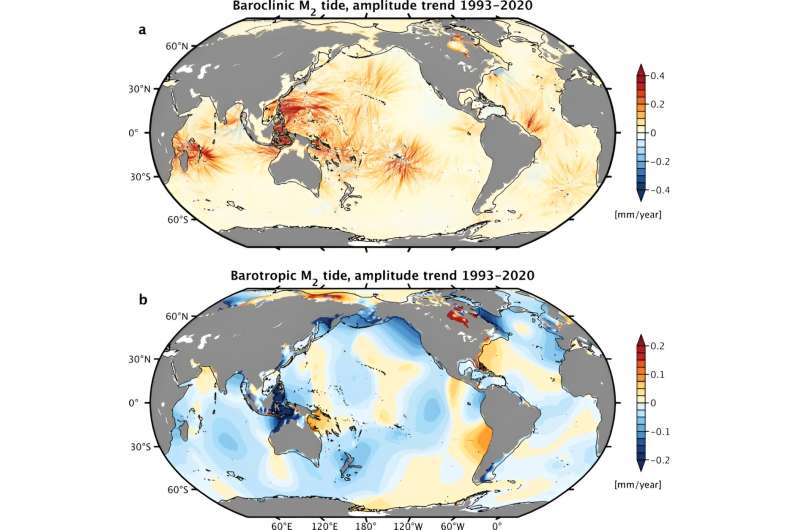This article has been reviewed according to Science X's editorial process and policies. Editors have highlighted the following attributes while ensuring the content's credibility:
fact-checked
proofread
New 3D models reveal how warming climate affects underwater ocean tides

Few things in nature are as predictable as ocean tides. Driven by the moon's and sun's gravitational pull, these persistent, short-period, and large-magnitude phenomena are apparent in nearly all types of oceanographic and satellite observations. They also directly impact the rhythm of life for millions of people and countless ecosystems.
But lately, researchers have noticed subtle changes in surface tidal measurements that do not coincide with changes in the moon and sun's gravitational pull. Instead, collected data and theory indicate that a warming ocean surface may be behind the observations.
To investigate these phenomena, Dr. Michael Schindelegger at the University of Bonn has been utilizing supercomputing resources at the Jülich Supercomputing Centre (JSC) to better understand observational data collected between 1993–2020, improving the accuracy of three-dimensional (3D) ocean circulation models in the process.
The research is published in the journal Communications Earth & Environment.
"Tides often mask other potentially interesting and less predictable signals related to, for example, the general circulation of the ocean or effects of climate change," explains Schindelegger. "Pulling climate signals from oceanographic observations also depends on the accuracy with which we can model tides, including their potential changes over time."
Internal currents add complexity
Scientists estimate that the upper 700 meters of the ocean absorb around 90% of the excess heat being trapped in the warming climate system. As this zone of the ocean warms up, it also expands and becomes less dense, leading to a higher contrast in water density compared to lower levels of the ocean that remain cooler and denser.
Specifically, Schindelegger and his colleagues are exploring the interactive relationship between a warming climate, ocean stratification as a measure of the density contrast, and two types of tidal currents: barotropic tides, which refer to the periodic motion of ocean currents associated with gravitational forces; and baroclinic or internal tides, which occur when barotropic tides flow against underwater topography, like a ridge, causing waves of denser water from the deep to push upward into less dense surface water.
"Warming in the upper ocean enhances the energy transfer from barotropic to baroclinic tides, such that the open-ocean tides are now losing a few percent more tidal energy to internal waves than they did three decades ago," explains Schindelegger. To assess the severity of these changes and predict their impact on coastal regions, simulations have become an essential tool.
Observational data and modeling must work together
Observing and modeling ocean tides is nothing new, and fresh data to work with becomes available every hour of every day. However, collected data near the coast can be afflicted with "noise" and errors, while computer models are always simplified representations of processes in the real world. This is why, according to Schindelegger, it is imperative to consider both observational data and models when testing for tidal changes.
Furthermore, considering tides in a more realistic, stratified ocean—including these baroclinic tides—means that established 2D ocean models would need to be expanded to include depth as a third dimension and have a higher horizontal resolution to achieve useful accuracy.
"Early attempts at modeling were restricted to a one-layer, constant-density ocean model, which I could even run on a single CPU," Schindelegger says. "But as I began researching the causes for changes in the ocean tides, especially the effects of stratification, 3D general circulation models became essential."
Schindelegger says he spent about five years gradually adding complexity to the model, but it became clear that to achieve the necessary resolution for accurate 3D models, more computing power would be needed. For this reason, Schindelegger and his colleagues turned to JSC's supercomputer, JUWELS.
"As the computational grid also extends into the vertical direction, we have about 300 million grid points to diagnose the relevant variables of pressure, temperature, and salinity from the model's equations," Schindelegger says.
"We had to use one million core hours to successfully execute the project. Distributing the task to a large number of computational nodes was key to achieving feasible runtimes and avoiding memory issues. The resources available on JUWELS provided the necessary foundation for this kind of application."
Predicting future tides
Schindelegger says that, although these surface tidal changes are subtle so far—an approximately one-centimeter drop over several decades at the coast, and even less in the deep ocean—it is still worthwhile to continue improving the 3D model until it can predict with reasonable accuracy how these changes in ocean stratification will impact coastal regions in the future. Especially for places like the Gulf of Maine or northern Australia, where the tides are pronounced and encounter complex underwater topography, even these small changes can have considerable implications.
With continued access to supercomputing resources, Schindelegger and his collaborators will leverage a powerful tool to complement studying observational data. Taken together, these two research methods will help researchers in the geosciences better understand the role that a warming ocean plays for tides and their role in the climate system.
More information: Lana Opel et al, A likely role for stratification in long-term changes of the global ocean tides, Communications Earth & Environment (2024). DOI: 10.1038/s43247-024-01432-5
Provided by Gauss Centre for Supercomputing





















